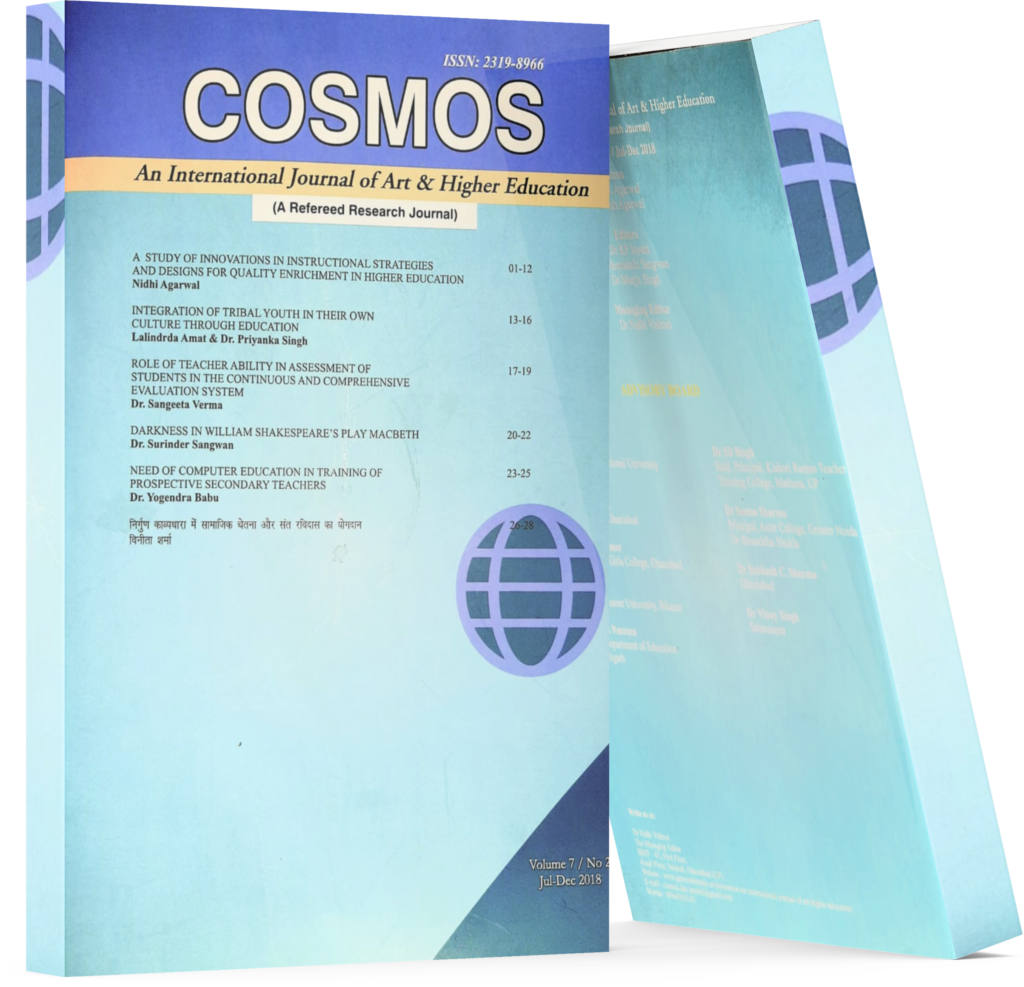An Evaluation Of The Status Of Infrastructure And Educational Facilities In The Municipal Schools Of The Mumbai Region Using The Undps Multi-Dimensional Poverty Index (Mpi) Approach
Keywords:
BMC Schools, Multi-Dimensional Poverty Index (MPI), UNDP, Education, marginals.Abstract
This electronic document is a “live” template and already defines the components of your paper [title, text, heads, etc.] in its style sheet. One book, one pen, one child, and one teacher can change the world quoted Malala Yousafzai. And to facilitate this, all one needs is a school. Today, the role of the school from being just a four walled structure has enlarged to accommodate a larger perspective which includes a myriad of activities encompassing the overall development of the child. Apart from basic education, a host of pre-requisites have become the norm – be it the plethora of activities related to sports, or activities related to the development of the creative genius, or activities intending to develop the overall personality including Emotional Quotient and the Intellectual Quotient of the child. Education today, albeit, does concentrate on teaching and learning nevertheless, the focus and the selling point has now shifted to the availability of facilities. Thus, with the array of schools today, showcasing their infrastructure and facilities in our visible universe, the choices for a parent to enroll their young minds are superfluous. There are schools which are of international stature and those who are not international, aspire to be one. Then come the residuals - the municipal run schools, often alleged to be overlooked by both the enrollers and the facilitators. And yet they have an audience - the marginals for whom education is a virtue and getting it completed in the limited available options is an obligation. Often symbolized as a place for education for those with limited financial viabilities, do these institutions necessarily mirror poverty and insignificance? Are these schools sustainable and guarantee the development of the child to compete in the ever challenging environ of today’s world? Do they have the infrastructure facilities which can bring out holistic development of the child? We put this to test by examining these schools run by the Brihan Mumbai Municipal Corporation (BMC) in the eastern suburbs of Mumbai, where several schools were visited and examined under various indicators such as Classroom Infrastructure, Teaching Infrastructure and other collaterals for a school. To do this differently we used Oxford and UNDPs (United Nations Development Programme) Multi-Dimensional Poverty Index approach - a concept used in Macro Economic Analysis to calculate the Poverty Index and Depravation of households in a country. We remodeled this economic concept to calculate the depravation index of these BMC run schools in the Mumbai region. The results obtained - though not startling yet reaffirming, indicated that most of these schools can be classified as less deprived withstanding the fact that they do provide what they set out to do - that is basic education.
Downloads
References
Tilak, Jandhyala (2016). Rejuvenation of Government Schools in India. 10.13140/RG.2.1.4318.4881
Gouda, J., Chandra Das, K., Goli, S. and Maikho Apollo Pou, L. (2013). "Government versus private primary schools in India: An assessment of physical infrastructure, schooling costs and performance". International Journal of Sociology and Social Policy, 33(11/12), 708-724. https://doi.org/ 10.1108/IJSSP-12-2012-0105.
De, A., Majumdar, M., Samson, M. and Noronha, C. (2002), Private schools and universal elementary education, in: R. Govinda (Ed.) India education report: A profile of basic education (Oxford, Oxford University Press).
-150.
Pandey, Priyanka, Goyal, Sangeeta, Sundararaman, Venkatesh (2008), Public Participation, Teacher Accountability, and School Outcomes: Findings from Baseline Surveys in Three Indian States. Policy Research Working Paper No. 4777, World Bank.
Tooley, James and Dixon, Paula (2006). De facto’ privatization of education and the poor: implications of a study from sub-Saharan Africa and India. Compare, 36(4), 443-462.
Muralidharan, Karthik and Kremer. Michael (2006). Government and Private Schools in Rural India. Manuscript, forthcoming in School Choice International, edited by Paul Peterson and Rajashri Chakrabarti.
Lall, Marie, Anand, Kusha, Bali, Megha, Banerji, Aditi, Jain, Samta, Khan, Feroz and Singh, Anviti (2020). What works and why in Indian government schools - Teachers’ voices in Delhi NCR, Policy Brief.
Kundu (2019). Deteriorating Quality of Education in Schools Are Teachers Responsible? Economic and Political Weekly, 54 (24), 34-41.
Mohd Ibrahim, Nuraihan & Osman, Mariana & Bachok, Syahriah & Mohamed, Mohd. (2016). Assessment on the Condition of School Facilities: Case Study of the Selected Public Schools in Gombak District. Procedia - Social and Behavioral Sciences, 222, 228-234. 10.1016/j.sbspro.2016.05.151.
Hasbullah, Amilia, Zahari, Wan, Yusoff, Wan, Ismail, Maziah and Vitasari, Prima (2011). A framework study of school facilities performance in public primary school of Batubara district in Indonesia. Procedia -
Social and Behavioral Sciences, 15, 3708- 3712, ISSN 1877-0428, https://doi.org/ 10.1016/j.sbspro.2011.04.360.
Bhunia, G.K. Shit, P.K. & Duary S. (2012). Assessment of School Infrustructure at Primary and Upper Primary Level: A Geospatial Analysis. Journal of Geographic Information System, 4, 412-424.

